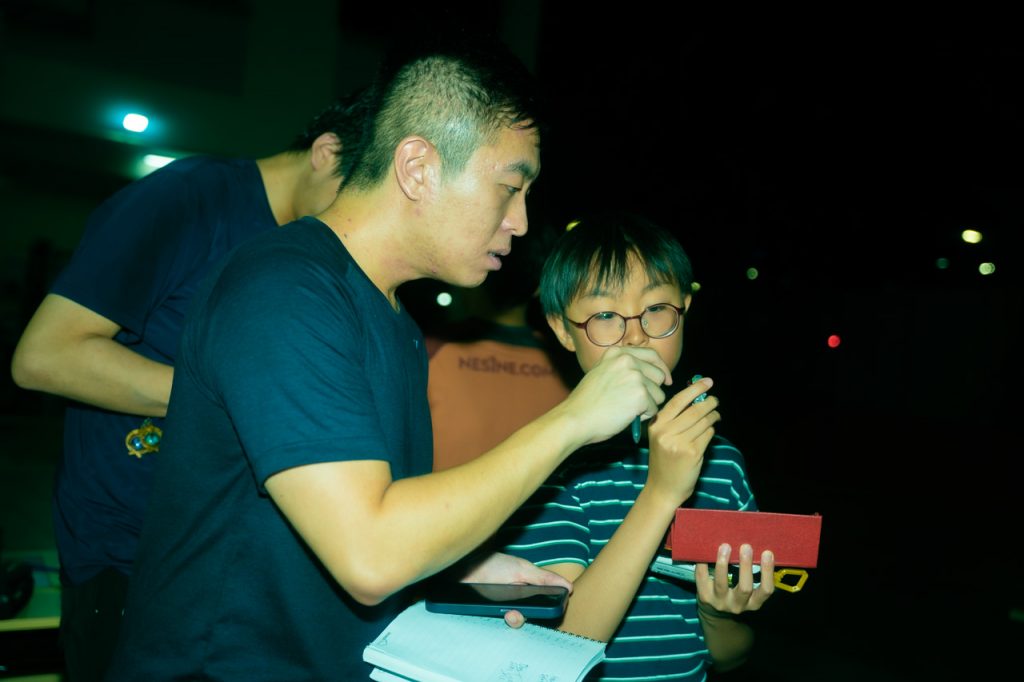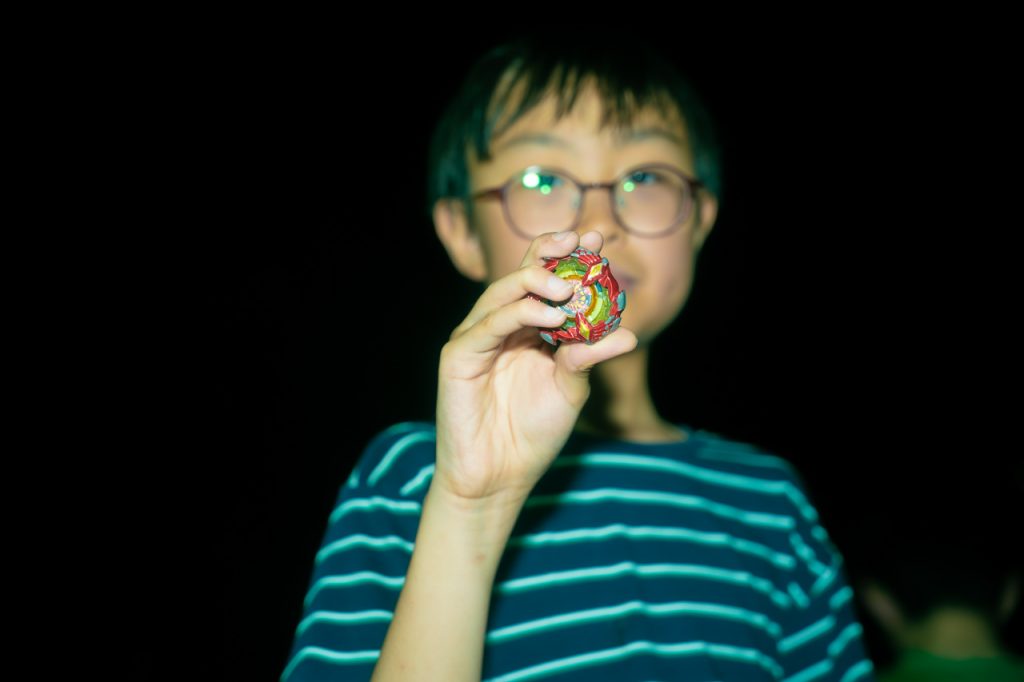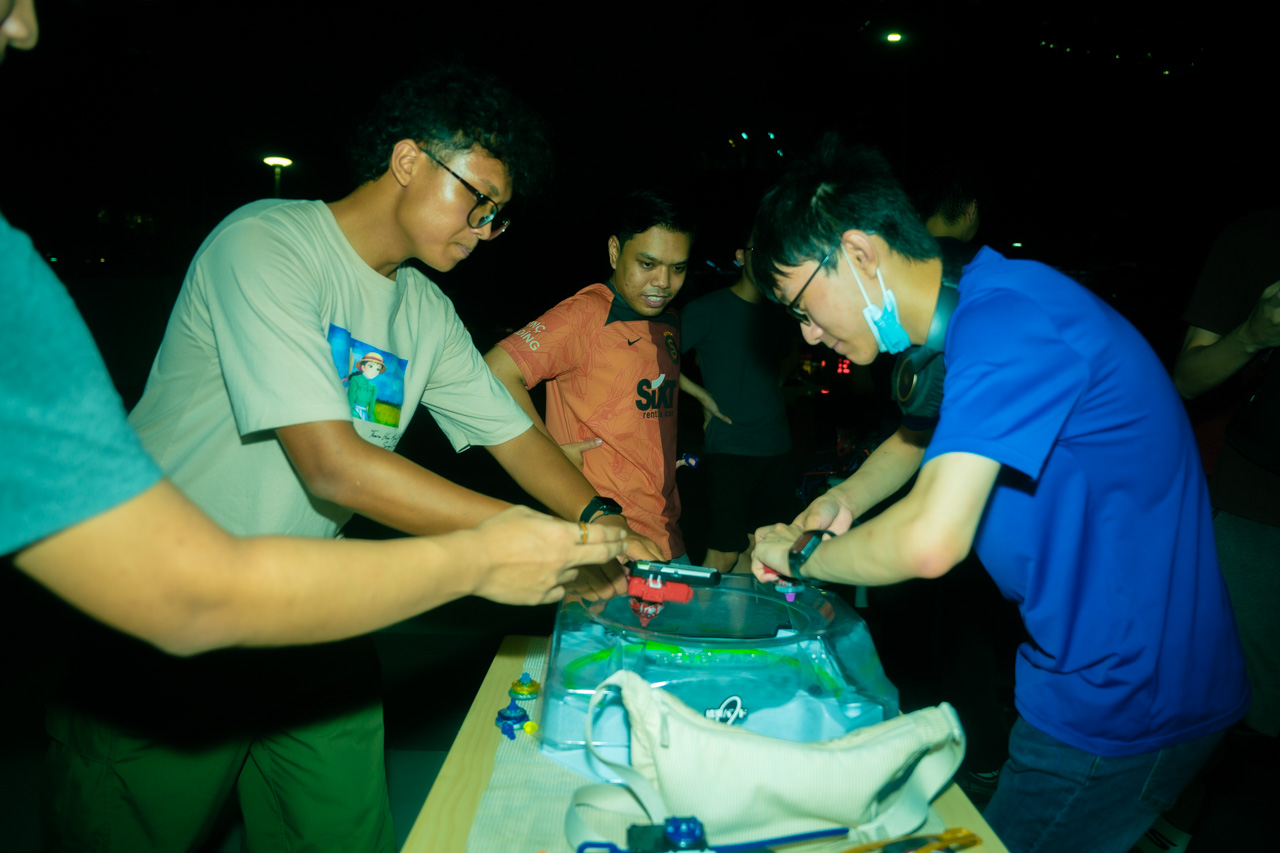All images by Xue Qi Ow Yeong for RICE Media
On most weekday evenings, you’ll find Samuel Lim launching Beyblades and battling it out at void deck tournaments. On weekends, he’s hitting toy stores like Kiddy Palace to compete in official Beyblade tournaments.
Samuel is 33 years of age. And he’s a proud millennial Beyblader.
ADVERTISEMENT
In the 2000s, you could throw a stone at any void deck and hit a bunch of boys spinning their plastic tops as they yelled, “Let it rip!”. Parents generally tolerated Beyblade mania as long as it didn’t mess up the house or their kids’ grades.
The game is simple. All you really need is a modular spinning top (known as a Bey), a launcher, and a plastic domed Beystadium where the tops fight for spinning dominance.
The craze for the tops by Takara (now Takara Tomy) was driven by the Beyblade anime and manga series, as well as its perpetual void deck presence. Kids saw their friends flexing their shiny new Beyblades and quickly procured their own.
Nowadays, the scene has plenty of people in their twenties, says Samuel, an IT manager. But really, it’s good fun for all ages. He’s been seeing more parents and kids turn up at events and play alongside each other.
Even so, there’s still a strong perception that it’s a ‘childish’ activity, Samuel acknowledges.
Once, a colleague happened to catch him at a casual void deck Beyblade session. The following day, when she asked him about it, she called Beyblading “a manchild activity”.
Samuel is not upset in the slightest when he recounts the awkward incident. He understands why people might judge him for playing with what’s essentially a toy marketed for children. But he’s not letting it get in the way of his hobby.
“I just want to have fun. As long as I don’t harm anybody along the way, I don’t see why I can’t.”

Slowly but surely, Beyblades are seeing a resurgence in Singapore. Maybe it’s the toy’s flashy new polish. Maybe it’s millennial nostalgia for the 2000s. Maybe it’s the toy distributors working overtime to keep things interesting by organising tournaments and community events.
ADVERTISEMENT
Or maybe there’s a simpler explanation. Spinning stuff is fun, no matter how old you are. Who says hobbies have to be high-brow or grown-up to be worthwhile?
A History of Spinning Things
In terms of overall prestige, though, the local Beyblade scene has been making strides over the years.
Back in the early 2000s, void deck Beyblade battles were a lawless land. You’d see DIY modifications like rough metal disks in the tops. Losers would have to hand over their tops to the winner. Kids who couldn’t afford official stadiums would either get cheap knockoffs from neighbourhood toy stores or set up their own makeshift arena with pencils on the ground.
Now, most players stick to official rules and go by a point system: three points when the Bey is knocked out of the arena, two points for a burst finish (when a part is knocked loose), and one point for a spin finish (when one Bey outlasts the other). The first player to four points wins.

Weekly official tournaments at stores like Toys”R”Us are run by staff called Game Masters, who ensure fair play. Winners of national tournaments get the opportunity to represent Singapore in overseas competitions like the Southeast Asia Cup and Asia Cup.
“It really helps to set all these game rules. It really feels like a proper sport,” Sam tells me. Even as he pays the haters no mind, anything that lends legitimacy to his hobby is a good thing in his book.
In defence of Sam—and other adult Beyblade enthusiasts I spoke to—humankind has been spinning things on the ground for a really, really long time. As evidenced by the universal appeal of the spinning top, ancient Mesopotamians, Chinese, and Egyptians all had their own versions of the toy.
Even way before the first generation of Beyblades was released in 1999, pre-colonial Singaporeans living in kampungs gathered to play with wooden egg-shaped tops called gasing.
Gasing, which dates back to the 15th century, would often be played at the end of the harvest season, when farmers had more time for R&R. Funnily enough, the way our ancestors played with the gasing is remarkably similar to the Beyblades of today.
Players would wrap a string around their gasing and fling it forward to release. To win a gasing match, you’d have to either outlast your opponent or knock their top out of bounds.
It’s kind of amusing to think of Singaporeans of generations past hunkered over a circle in the dirt, eyes fixed intently on the battling tops. Fast forward to the present day, and you’ve got their descendants doing the exact same thing. Only, instead of a gasing, it’s a polycarbonate, modifiable top. And instead of a circle in the dirt, the battleground is a small plastic bowl-shaped arena.
No matter how old you are, it’s hard to tear your eyes away from two spinning objects battling for dominance. You somehow, inexplicably, end up rooting for one over the other. Maybe it’s this universal appeal that’s cemented Beyblade’s popularity here and overseas.

Still Spinning
They might have gradually disappeared from our void decks over the years, but Beyblades never really left Singapore.
And lately, it seems like they’re in vogue again. Part of the uptick in players recently has to do with the new Beyblade generations, Samuel theorises.
Beyblades change generation every few years. First, there was the Plastic generation that most millennials remember. Next was the Metal generation. Then came the Burst generation, which featured fancy features like connecting via Bluetooth to an app for wireless control.
Now, we’re well into Beyblade X, where the Beys (as those in the community call these tops) look cleaner and simpler.

Samuel explains that with the start of the new Beyblade X generation last October, it felt like the perfect time to get back into it because it was a fresh start. Rather than catching up on years of Beyblade Burst strategy and lore, he could start off on the same foot as all the other Beyblade hobbyists.
He even started a Beyblade enthusiast Telegram group called EatFresh (no special meaning behind it—he just happened to be munching on Subway when he created it).
EatFresh was meant to be a group for players to exchange battle pictures and footage, but it soon became clear that members were itching to meet up and battle outside of the official tournaments on weekends. Now, there’s an informal void deck session organised by a member nearly every other day, Samuel tells me.
I sense that for many of these players, Beyblades are a much-needed diversion from the daily drudgery of adulthood.
22-year-old Muhammad Mustaqim, whom I meet at a void deck Beyblade tournament organised by Sam, says the social aspect of the game keeps him coming back.
“If I compare Beyblade to other hobbies like playing video games, I just feel like it’s really good company. It’s good to actually see people physically.”
The void deck tournament is a simple set-up: just a few Beyblade arenas set up on tables borrowed from the nearby Residents’ Committee (RC). That’s really all you need for a Beyblade sesh.
It’s almost identical to the void deck tournaments of yesteryears. Except that players now no longer say “Let it rip”. I ask one player about it, and he laughs. Apparently, new-gen players now say, “Three, two, one! Go shoot!”. I’ve basically just given away my age.
As if I didn’t already feel ancient enough, a couple of kids show up with their parents in tow, but they aren’t intimidated by the adult Beybladers at all.
Finn Ng, a sprightly 10-year-old kid, volunteers to speak to me because he “wants to be famous”.


He’d discovered Beyblades sometime in 2021 when he saw the Beyblade anime series on Netflix, he says. It wasn’t long before he got his dad and younger brother, now seven, hooked as well.
“It’s very exciting. I feel a thrill when I play.”
Even though he isn’t afraid of going up against adults, he’s humble when I ask about his Beyblade skills: “I feel that I’m just okay only. Because Beyblade requires skill and luck.”
Players mill around, showing each other their Beys and talking strategy. There’s an easy camaraderie, and Finn gets high fives from the adults after each round. For the couple of hours they’re there, nobody talks about work or school. All that matters is Beyblade.
The Big Leagues
The next time I see Finn, it’s at nationals. He’s among the top 16 kids in Singapore who are battling it out.
It’s a far cry from the void deck tournaments. For one, it’s at the atrium of Bugis+, with crowds of onlookers watching closely.

This officially sanctioned competition creates a slight nervousness among players—all vying for attractive prizes like gold, silver, and bronze Beyblades.
The stakes are high. The top open category player (aged 13 and up) and the top two kids (aged 12 and below) will be heading to Malaysia to battle for the Southeast Asia Cup.
With his three Beys and a hip holster to hold his launcher, Finn already looks like a Beyblade champion.

Unfortunately, Finn doesn’t make the semifinals, but he stays on to cheer on his dad Gabriel, who bags fourth place in the open category.
Jeremy Lim, a 28-year-old marketing executive at Sheng Tai Toys, tells me that it’s events like these that help introduce Beyblade to a wider audience.
Indeed, we overhear more than a few shoppers exclaim some variation of “Oh wow, I didn’t know people still played Beyblade!” as they pass by the event.

Part of the community spirit we see today is also by design. While most enthusiast groups on Facebook are ground-up initiatives, Sheng Tai Toys is behind Singapore Beyblade Society. It’s a group where local Beyblade players get updates on events and new Bey launches, and answer each other’s queries.
A Beyblade enthusiast himself, Jeremy is a perpetual fixture in the Facebook group. You’d be hard-pressed to find a post that he hasn’t commented on or a query he hasn’t weighed in on.
The community is also incentivised to turn up at official tournaments held at stores like Kiddy Palace, Toys”R”Us, and Don Don Donki. They can earn stamps to redeem things like free stadiums and Bey Points. With enough points, you can enter raffles and stand a chance to win prizes.
In short, things are a lot more organised now. It also helps that the internet and social media make it easy to find other battlers and tournaments.
The mushrooming of communities like EatFresh is also evidence that Beyblade’s draw goes beyond being a fun, uncomplicated game. Sure, Beyblades are great, but the real appeal is having people to play them with.
Let It Rip

After the finals wrap up, the Beyblade enthusiasts who’ve been cheering in the crowd slowly amble over to the empty stadiums.
Like fish in a formation, they wordlessly, instinctively spread out and cluster around the plastic domes. Kids face off against adults. Mothers go up against fathers. People who don’t have Beys hang around, spectating and cheering players on.
As if all this wasn’t wholesome enough, I catch one father tearing up over his son’s tournament victory.
I remember a time when niche hobbies like trading cards and Tamiya cars were frowned upon and viewed as distractions from school. “Study hard, or I’ll throw away your Pokemon cards,” my mum used to threaten.
Today, societal attitudes have shifted. New-age Singaporean parents not only encourage their kids’ hobbies but actively participate in them. They recognise the value of shared interests and the joy these activities bring, fostering a more supportive environment for niche passions. In turn, kids deeply appreciate how much their parents care about their pursuits, even for something as small as plastic tops hitting each other.
And at its core, the game of Beyblade is really about coming together and enjoying the simple pleasures of a universally fun hobby that transcends age.
We rarely have time for unadulterated fun in our busy lives. Sometimes, it’s really as simple as a gathering around a spinning top.






